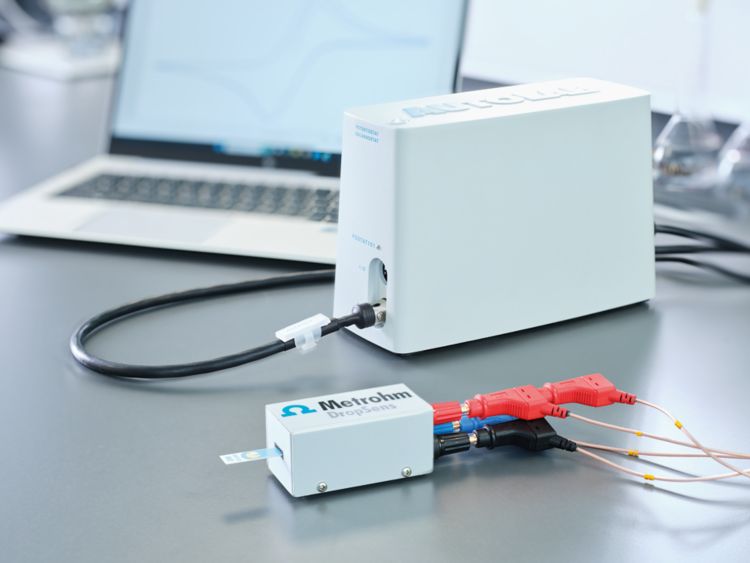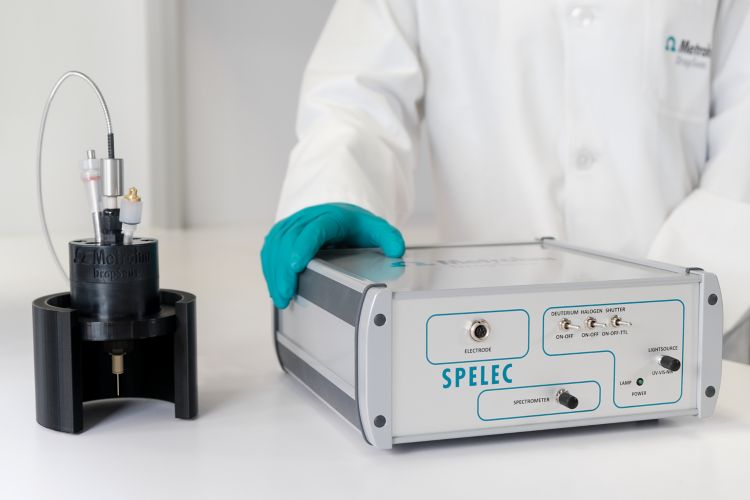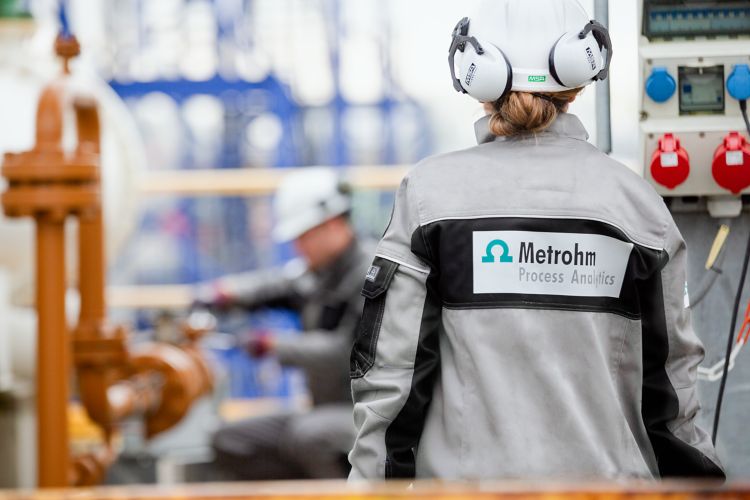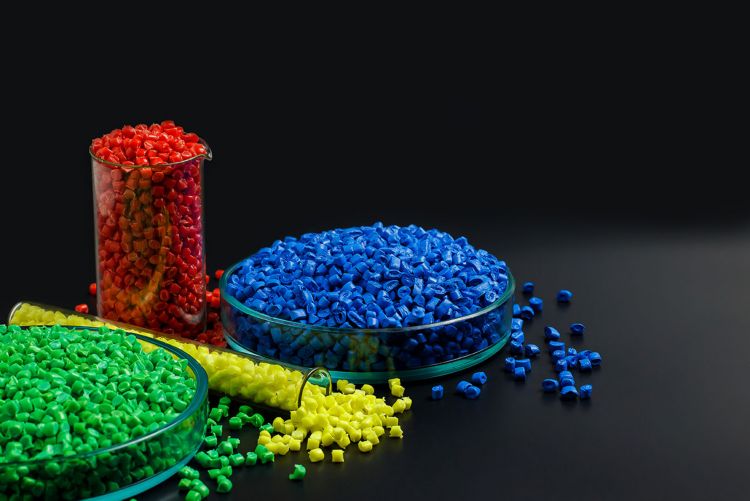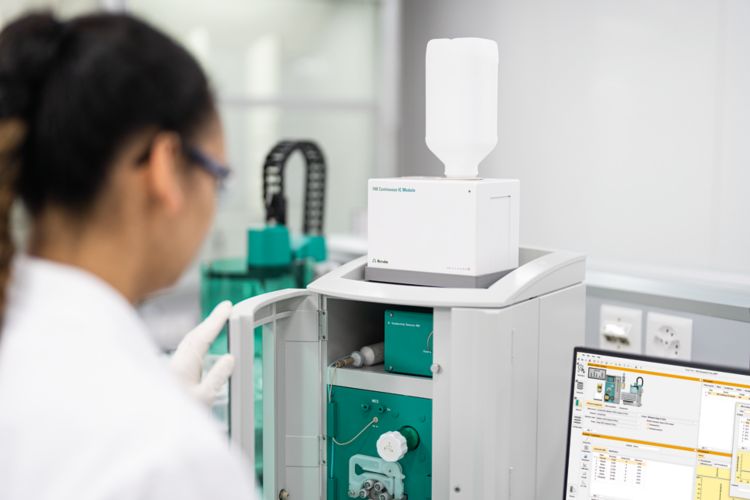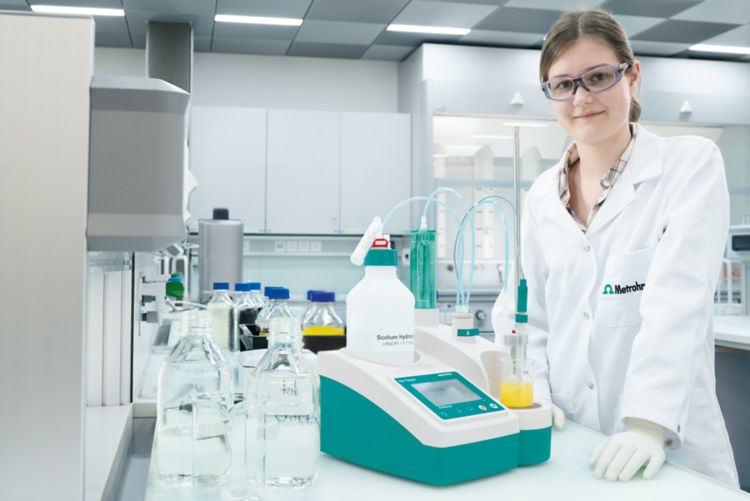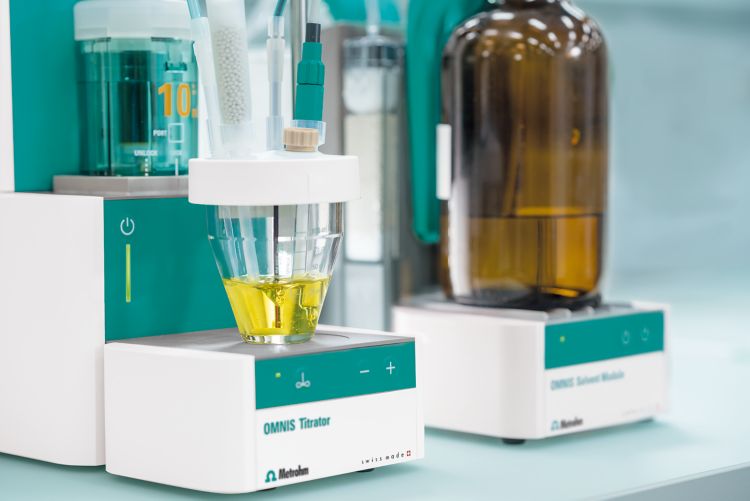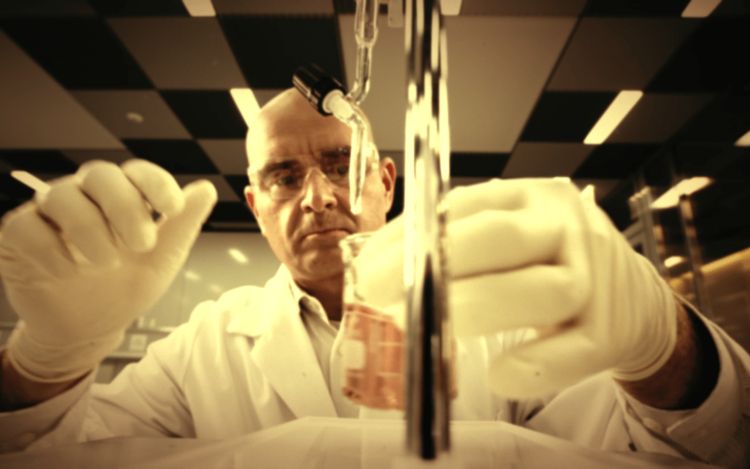Search
Market-leading solutions
Product families (100)Product configurations for any application
Product models (714)Tried-and-tested applications
Applications (2250)Trainings & webinars by experts
Events (4)Electrodes
Electrodes (509)Columns
Columns (155)Accessories
Accessories (2248)Software
Software (269)Manuals & brochures
Documents (2595)News
News (58)Inspiring industry insights
Insights (177)Unmatched support & service
Support & service (80)On-demand webinars
Webinars (69)Other content
Items (99)2.1001.0010
OMNIS Titrator without stirrer, without function licenseInnovative, modular potentiometric OMNIS Titrator. Thanks to 3S Liquid Adapter technology, handling chemicals is safer than ever before. The titrator can be freely configured with measuring modules and cylinder units and can have a stirrer added as needed. Thanks to various software function licenses, various measuring modes and functionalities are possible. Actuation via PC or local network; Connection option for up to four additional titration or dosing modules for additional applications or auxiliary solutions; Can be supplemented with magnetic stirrer and/or rod stirrer; Various cylinder sizes available: 5, 10, 20 or 50 mL; Liquid Adapter with 3S technology: Safe handling of chemicals and automatic transfer of the reagent dataMeasuring modes and software options:; Endpoint titration: "Basic" function license; Endpoint and equivalence point titration (monotonic/dynamic): "Advanced" function license; Endpoint and equivalence point titration (monotonic/dynamic) with parallel titration: "Professional" function license; Optional licenses for additional measuring, titration, and operating modes (e.g. volumetric Karl Fischer titration, conductometric or thermometric titration, coulometry, determination of the bromine index) ;
2.1008.0010
Eco TitratorThe compact Eco Titrator with integrated magnetic stirrer and touch-sensitive User Interface is ideal for routine analysis. It provides GLP-compliant results with minimum space requirements at all times (approx. DIN A4).Universally compatible with almost all potentiometric titrations, such as, for example, forFood products: Acid content, chloride, Vitamin C, iodine and peroxide number in fats; Water analysis: Carbonate and Ca/Mg hardness, chloride, sulfate, permanganate index; Petrochemistry: Acid/base number, sulfide & mercaptans, chloride, bromine number; Electroplating: Total acid, metal content, chloride; Surfactant analysis: Anionic, cationic and non-ionic surfactants; Photometry with the Optrode: p and m value, metals, water hardness;
2.1012.1010
OMNIS Sample Robot L Pick&PlaceOMNIS Sample Robot L with a "Peristaltic" (4-channel) pump module and a Pick&Place module in addition to extensive accessories for the direct transition to fully automatic titration. The system provides space in seven sample racks for 112 sample beakers of 120 mL each.The system can be extended upon request to include up to four peristaltic pumps and three additional Pick&Place modules, thus quadrupling the throughput while at the same time also guaranteeing long and interruption-free operation.
2.143.0200
TX-900MH impact printerCompact impact printer with USB and RS232 interface for 900 Touch Control (+); 915 KF Ti-Touch (+); 916 Ti-Touch (+); 917 Coulometer (+); 91X Meter (+)Eco Dosimat/Titrator (+); 877/848 Titrino plus (additional 6.2151.100 required); 865/876 Dosimat plus (additional 6.2151.100 required); 862 Compact Titrosampler (additional 6.2151.100 required); 870 KF Titrino plus (additional 6.2151.100 required); 899 Coulometer (additional 6.2151.100 required); (+) Cable included in scope of delivery
2.780.0010
780 pH MeterIn addition to pH, voltage and temperature measurement, the 780 pH Meter also offers an automatic stirrer control, a multi-point calibration with up to nine buffers, a method memory and various monitoring functions. The automatic pH electrode test in conformance with GLP permits objective assessment of the electrode. The large backlit multi-line display provides an overview and makes the individual settings easy. The bi-directional RS-232 interface enables data transfer to a printer or PC.
2.781.0010
781 pH/Ion MeterIn addition to pH, ion, voltage and temperature measurement, the combined 781 pH/Ion Meter also offers an automatic stirrer control, a multi-point calibration with up to nine buffers (pH mode), a method memory and various monitoring functions. The automatic pH electrode test in conformance with GLP permits objective assessment of the electrode. The large backlit multi-line display provides an overview and makes the individual settings easy. The bi-directional RS-232 interface enables data transfer to a printer or PC.Three different modes are available for ion measurement: direct measurement, standard or sample addition. In the case of fully automated standard addition with an optional Dosimat, only the concentration of the standard and the desired quantity of addition steps need to be entered, the pH/ion meter takes care of the rest. Up to 19 standards can be used for the calibration for direct measurement.
2.856.0010
856 Conductivity ModuleConductivity measuring module as supplement to an existing Titrando system or "stand-alone" in combination with a 900 Touch Control. With the 856 Conductivity Module, not only conductivity and temperature can be determined, but also TDS and salinity. It supports state-of-the-art conductivity measuring cells, i.e. 5-ring measuring cells. The Conductivity Module is equipped with two USB interfaces for connecting printers, barcode readers, or sample changers and four MSB interfaces for stirrers or Dosinos.For use with OMNIS Software, tiamo software, or Touch Control unit. Compliance with GMP/GLP and FDA regulations such as 21 CFR Part 11, if required.
2.856.0110
856 Conductivity Module with Touch Control, including 5-ring conductivity measuring cellHigh-end conductometer, based on the 856 Conductivity Module, including 900 Touch Control, 5-ring conductivity measuring cell and calibration standards. With the 856 Conductivity Module, not only conductivity and temperature can be determined, but also TDS and salinity. It supports state-of-the-art conductivity measuring cells, i.e. 5-ring measuring cells.The Conductivity Module has two USB interfaces for connecting printers, barcode readers or sample changers and four MSB interfaces for stirrers or Dosinos. In combination with the 900 Touch Control, the 856 Conductivity Module is in compliance with GLP and FDA 21 CFR part 11 requirements.
2.867.0010
867 pH ModuleModule for pH/ion measurement as supplement to a Titrando or "stand-alone" in combination with a 900 Touch Control.In addition to measurements of pH, temperature, mV, Ipol, Upol and concentration, the pH Module can perform standard additions (manual, dos, autodos) and Liquid Handling (add, prep, empty). It enables the use of both conventional and intelligent sensors for measuring. Also integrated in the software is an automatic GLP-compliant pH electrode test.The pH Module has two USB interfaces for connecting printers, barcode readers or sample changers and four MSB interfaces for stirrers or Dosinos (for the addition of auxiliary solutions or for standard addition).For use with OMNIS Software, tiamo software, or Touch Control unit. Compliance with GMP/GLP and FDA regulations such as 21 CFR Part 11, if required.
2.867.0110
867 pH Module with Touch ControlHigh-end pH/ion meter based on the 867 pH Module, including 900 Touch Control, 854 iConnect and intelligent "iUnitrode" pH glass electrode.In addition to measurements of pH, temperature, mV, Ipol, Upol and concentration, the pH Module can perform standard additions (manual, dos, autodos) and Liquid Handling (add, prep, empty). It enables the use of both conventional and intelligent sensors for measuring. Also integrated in the software is an automatic GLP-compliant pH electrode test.The pH Module has two USB interfaces for connecting printers, barcode readers or sample changers and four MSB interfaces for stirrers or Dosinos (for the addition of auxiliary solutions or for standard addition).In combination with the Touch Control, it is in compliance with GLP and FDA 21 CFR part 11 requirements.
- 410000001-C410000001-CChoosing the Most Suitable Laser Wavelength For Your Raman Application
Raman instrumentation can use lasers of different laser excitation, giving the same Raman spectrum for a sample. This paper presents the specific strengths and weaknesses that different excitation wavelengths provide, allowing a user to optimize the measurement of different samples by their choice of Raman excitation laser wavelength.
- 410000002-B410000002-BCarbon Black At-line Characterization Using a Portable Raman Spectrometer
In this article portable Raman spectroscopy as an effective tool for at-line characterization of carbon black is presented. Raman spectroscopic analysis can be an effective test to characterize carbon black material, including the structural order.
- 410000003-A410000003-APortable Raman Spectroscopy for the Study of Polymorphs and Monitoring Polymorphic Transitions
Raman spectroscopy is used for material characterization by analyzing molecular or crystal symmetrical vibrations and rotations that are excited by a laser, and exhibit vibrations specific to the molecular bonds and crystal arrangements in the molecules. Raman technology is a valuable tool in distinguishing different polymorphs. Examples of portable Raman spectroscopy for identification of polymorphs and in monitoring the polymorphic transiton of citric acid and its hydrated form are presented.
- 410000004-A410000004-ARaman Spectroscopy in Archaeological Studies
Portable Raman spectroscopy is an invaluable tool in the study of archaeological sites, allowing for in situ analysis which minimizes the impact of such studies on important cultural sites. The flexibility of the use of a fiber optic probe and tripod-mounted video microscope with a light weight instrument reduces the need for sampling, and increases the ability to make representative measurements over what can be very large sample areas. The information content of Raman spectroscopy aids in the understanding of the materials used in the construction and restoration of important archaeological sites, and in understanding the degradation that is occurring which should aid in preservation and restoration work.
- 410000005-B410000005-BPortable Raman Instrumentation for SERS Applications
For SERS developers and end users of SERS for specific applications to investigate low concetation levels of compounds, the centerpiece of their technological platform must be a Raman setup that provides reliable lab grade performance and is affordable and portable, allowing them to tackle real world problems. The portable i-Raman Plus system coupled with a BAC151 video microscope sampling accessory provides an ideal setup. With the performance and flexibility of use with different laser spot size and power for SERS research.
- 410000006-BLow-frequency Raman spectroscopy
Raman spectroscopy is an advantageous analytical tool that allows for the measurement of molecular structure and identifying chemical composition of materials based on the rotational and vibrational modes of a molecule. With advanced technology and an optimized optical design, the B&W Tek BAC102 series E-grade probe can access lower frequency modes down to 65 cm-1, providing key information for applications in protein characterization, polymorph detection, and identification, along with material phase and structure determination.
- 410000008-A410000008-ARaw Materials Identification through Multiple Polyethylene Bags
The NanoRam is able to test material through multiple layers of transparent plastic bags. Postive identification of material on PE bags from 1 to 9 layers were obtained, demonstrating minimum interference from the PE bags on the material identification result.
- 410000009-A410000009-ARapid Identification of Heroin with Handheld Raman
Raman spectroscopy is used widely by law enforcement as a field screening tool due to its speed, selectivity and ease of use. The majority of materials can be identified by the Raman signature, as they exhibit sharp distinctive peaks serving as a molecular fingerprint. However, many street and real-world samples are dark in color and not pure. The dark color, often due to impurities, gives rise to fluorescence that interferes with the Raman measurement. One method to suppress the fluorescence of a sample and enhance the Raman activity / signal is by the use of Surface-Enhanced Raman Spectroscopy (SERS).
- 410000012-A01410000012-A01Rapid Detection of the Low Dose API in Xanax Using Surface-Enhanced Raman Spectroscopy for Anti-Counterfeiting Purposes
The emergence of counterfeit prescription drugs has become a concern for the pharmaceutical industry. Because of the low concentrations of APIs found in pharmaceutical drugs, normal Raman spectroscopy is typically not sensitive enough to detect the API from the surface of a pill. In this study we develop a surface-enhanced Raman spectroscopy (SERS)-based approach to identify a low-dose of the API alprazolam in a Xanax tablet using a handheld Raman spectrometer. If no SERS peaks consistent with alprazolam are observed from a Xanax tablet, the pill is a suspected fake. The method demonstrates the power of SERS to quickly verify the presence of alprazolam in the tablet for anti-counterfeiting purposes.
- 410000013-A410000013-AFast and Selective Detection of Trigonelline, a Coffee Quality Marker, Using a Portable Raman Spectrometer
Portable Raman is used to quantify trigonelline, an alkaloid that contributes to the health benefits of some foods. A simple method to quantify the presence of diluted trigonelline in solutions using surface enhanced Raman spectroscopy is described. Portable Raman is a tool that could be used in quality control of food items such as coffee and quinoa.
6.6068.202
StabNet 2.x fullPC program for data handling and instrument control of stability measuring instruments. The software permits checks, data acquisition, evaluation and monitoring, as well as generating reports on stability measurements.Graphical user interface for routine operations, extensive database programs, method development, system configuration, very flexible user administration, extensive data export functions, individually configurable report generator.StabNet Full complies with the directives according to FDA 21 CFR Part 11.Dialog languages: German, EnglishThe following instruments are supported:892 Professional Rancimat; 893 Professional Biodiesel Rancimat; 895 Professional PVC Thermomat; 1 license for max. 4 stability measuring instruments on one PC.
6.6069.412
Vision 4.1Vision is the Metrohm software solution for method development and for controlling Metrohm XDS process instruments and B&W Tek instruments The user-friendly graphics analysis interface makes it easy to apply chemometric algorithms for creating identification, qualification, and quantification methods.
6.6072.208
Vision Air 2.0 CompleteVision Air - Universal spectroscopy software. Vision Air Complete is a modern and simple-to-operate software solution for use in a regulated environment.Overview of the advantages of Vision Air: Individual software applications with adapted user interfaces ensure intuitive and simple operation; Simple creation and maintenance of operating procedures; SQL database for secure and simple data management; The Vision Air Complete version (66072208) includes all applications for quality assurance using Vis-NIR spectroscopy: Application for instrument and data management; Application for method development; Application for routine analysis; Additional Vision Air Complete solutions: 66072207 (Vision Air Network Complete); 66072209 (Vision Air Pharma Complete); 66072210 (Vision Air Pharma Network Complete);
DropView 8400
DropView 8400 SoftwareDropView 8400 Software is advanced but highly user-friendly software running µStat 300, µStat 400, μStat-i 400s, μStat-i 400, µStat 4000P, µStat 4000, µStat 8000P, µStat 8000 and µStat ECL equipments, controlling all their different functionalities
6.6068.114
StabNet 1.x Update 2.x fullUpgrade of StabNet 1.0 or 1.1 (Full) to Stabnet 2.X Full.
6.6069.414
Vision Multi 4.1Vision is the Metrohm software solution for method development and for controlling Metrohm XDS process instruments and B&W Tek instruments.The user-friendly graphics analysis interface makes it easy to apply chemometric algorithms for creating identification, qualification, and quantification methods.Vision Multi contains 5 multi-user licenses and is the ideal solution for setting up a server-client network.
6.6072.207
Vision Air 2.0 Network CompleteVision Air - Universal spectroscopy software. Vision Air Network is a modern and simple-to-operate software solution. The network version enables the structuring of a global server-client network with a central database.Overview of the advantages of Vision Air: Individual software applications with adapted user interfaces ensure intuitive and simple operation; Centralized data and instrument management; Simple configuration and updating of several devices in just a few steps ; The Vision Air Network Complete version (66072207) contains all applications for quality assurance using Vis-NIR spectroscopy: Application for a global instrument and data management; Application for method development; Application for routine analysis;
DropView SPELEC
DropView SPELEC SoftwareDropView SPELEC is a Spectroelectrochemical software that controls SPELEC instrument, offering a perfect synchronization of the optical and electrochemical measurements, as well as advanced tools for data treatment.
6.6068.921
StabNet 2.x full DemoDemo version for StabNet. Test version for 30 days.
6.6069.413
Vision Pharma 4.1Vision is the Metrohm software solution for method development and for controlling Metrohm XDS process instruments and B&W Tek instruments in a regulated environment. The user-friendly graphics analysis interface makes it easy to apply chemometric algorithms for creating identification, qualification, and quantification methods.
- Apr 8Live spectroelectrochemistry experiments with real users
Join us for a demonstration of the SPELEC by experienced users. They will showcase their experiments in real time, each one focusing on different spectroelectrochemical applications and working with different spectroelectrochemical techniques (UV-Vis and Raman with 785 and 532 nm lasers).
- Apr 29Electrochemical techniques for sensors research
This free webinar covers key electrochemical methods for sensor development, from cyclic voltammetry to electrochemical impedance spectroscopy, helping you confidently choose the right approach for your application.
- 10 - 14 JunFrankfurt, GermanyThe laboratory of the future on display at ACHEMA 2024
Metrohm presents the state-of-the-art in collaborative laboratory robotics: Completely unattended sample preparation and analysis of multiple wet chemistry parameters 24/7!
- Sep 28Converting from manual to automatic titration
Free webinar gives best practice guidelines on how to convert from manual to automatic titration. Laboratories can achieve higher accuracy and better reproducibility.
- Mar 17, 2025Digitalize your titration!
- Oct 11, 2024Webshop Registration
- May 27, 2020Rapid point-of-care testing using screen-printed electrodes from Metrohm DropSens
- Aug 23, 2021Ferrous iron detection in iron sucrose injection with polarography
Analyzing ferrous iron in iron sucrose injections for iron deficiency anemia treatment.
- Mar 23, 2020OMNIS meets Cubis® II
- Aug 21, 2021Real World Raman: Exposing fentanyl-laced, counterfeit, and illegal drugs
The handheld Raman spectrometer MIRA DS identifies illegal medications in Mexico and LA.
- Jan 20, 2020Applied thermometric titration: determination of iodine value (IV) in fats and oils
- Feb 10, 2020What's suppression in ion chromatography all about? Theoretical aspects and practical benefits explained.
- Jan 10, 2020Thermometry – the better method to determine total sodium in foodstuffs
Determining sodium and salt in food with thermometric titration from Metrohm.
- Oct 18, 2021Analysis of water samples and water constituents
Revised edition of monograph Analysis of water samples and water constituents with Metrohm instruments including methods, applications, and literature.


















